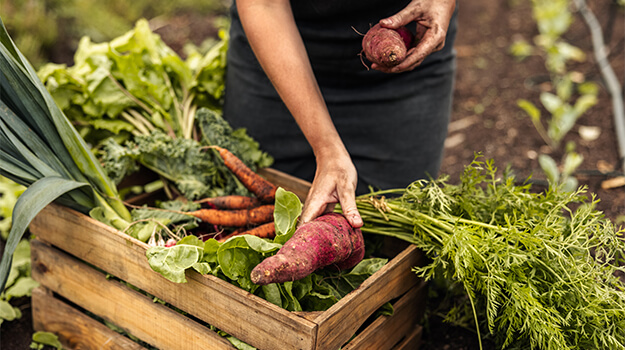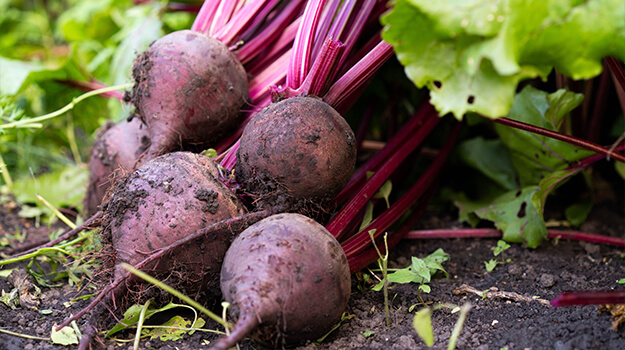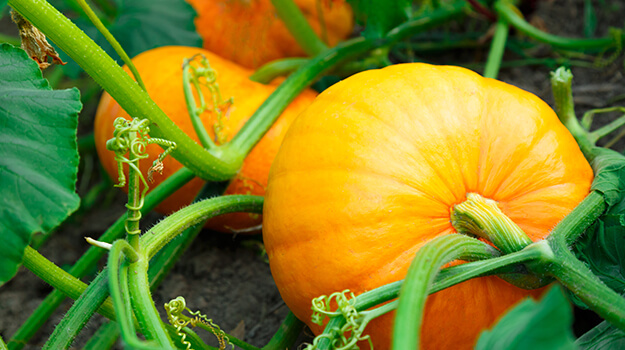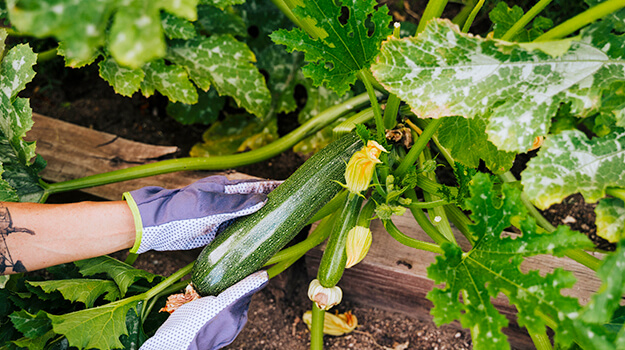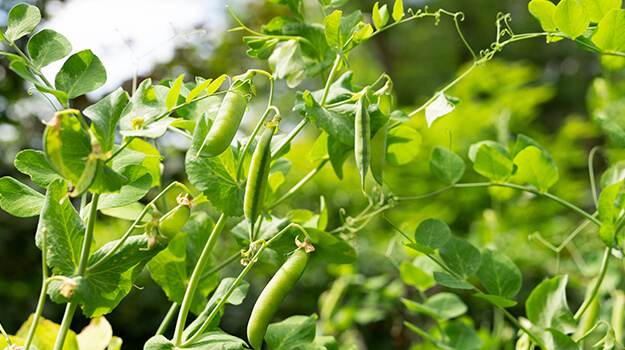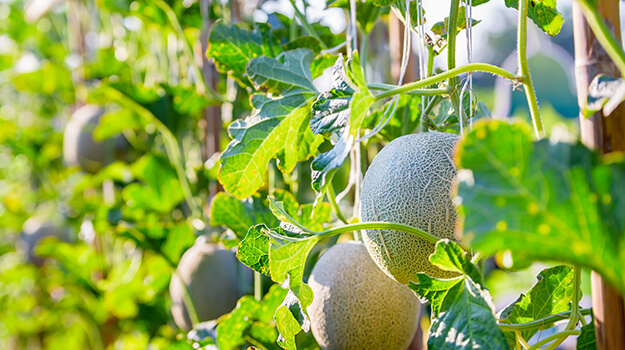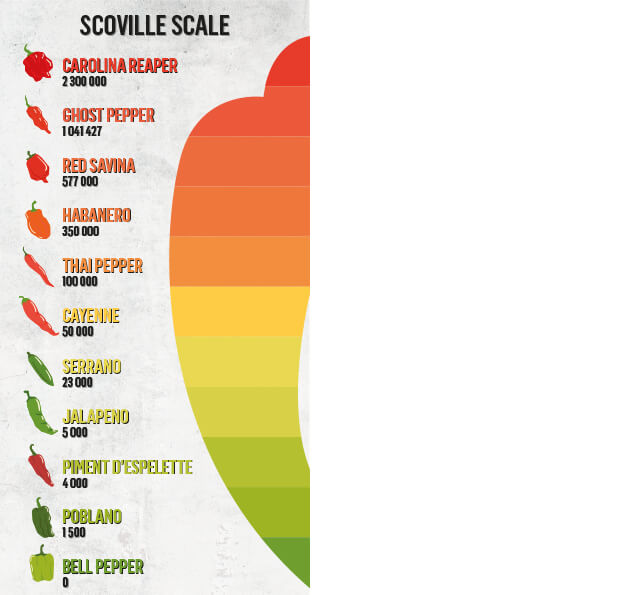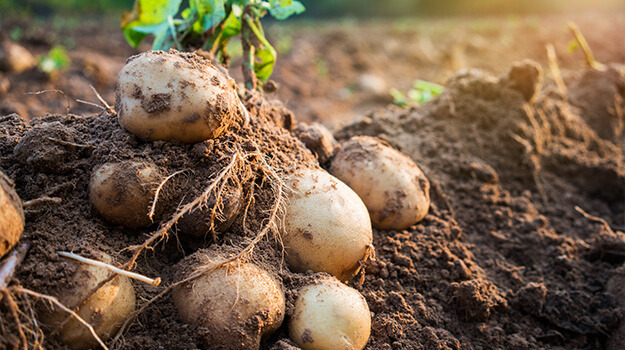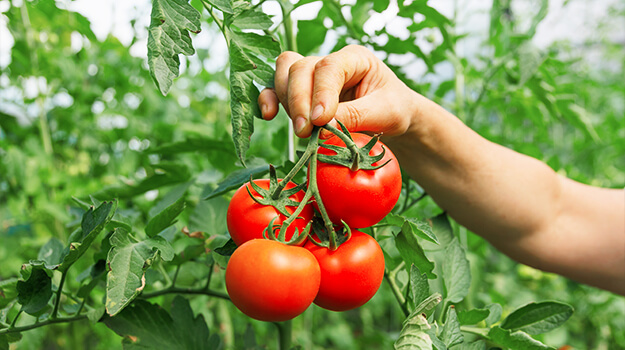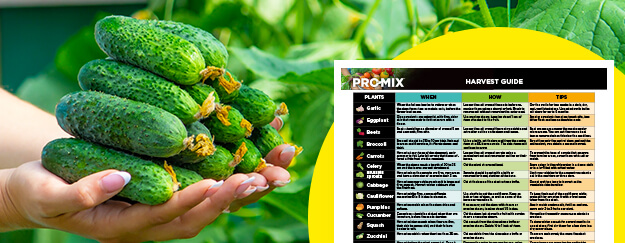To many experienced gardeners, this seems to be a matter of instinct, but it’s not so simple for everyone. For those folks, rest assured. There are some obvious signals to help you enjoy your garden vegetables when they are at their best.
Waiting for them to get bigger or sweeter is a mistake you only make once. The vegetables have a bitter taste, tough seeds and cracked skin. Most vegetables benefit from being consumed before they have reached complete maturity.
And there is no point in comparing! Garden vegetables have their own standards in terms of size and, fortunately, in terms of flavour!
When and how to harvest garlic
WHEN: Harvest when the foliage begins to yellow or when the stem forms two complete curls, before the flower bud opens.
HOW: Loosen the soil around the pods before removing them using a shovel or fork. Brush to remove soil without removing the outer peel.
TIP: Dry your garlic for two weeks in a dark, dry, well-ventilated place. Cut roots and stems when the bulbs are dry. Opened bulbs and detached cloves should be consumed within a week. If kept dry with some airflow and in the dark, unpeeled garlic bulbs will store for up to 6 months.
When and how to harvest eggplant
WHEN: Ripe eggplants are colourful, with firm, shiny skin that responds to light pressure with a finger. The varieties grown in the vegetable garden are often smaller than those in the supermarket.
HOW: Harvest your eggplants using pruning shears, keeping about 1 cm of stem attached to the fruit.
TIP: Smaller eggplants have less tough skin, less bitter flesh and less noticeable seeds.
When and how to harvest beets
WHEN: Beets should have a diameter of around 5 cm and a smooth, firm skin.
HOW: Loosen the soil around the root vegetable so that you can extract it by pulling on its stem and leaves. Brush under water and keep a maximum of one centimetre of stem.
TIP: You can eat the young beet leaves that you removed when thinning the seedlings. Beet greens are among the most popular microgreens. To find out more, read our article: Microgreens: Easy to grow at home
BONUS: Try our recipe for baked beet chips
When and how to harvest broccoli
WHEN: Broccoli should be 7.5 to 10 centimetres high. Its head is green and flowerless, its florets very dense and tight.
HOW: Using a knife, cut the broccoli from the centre stem at a 45-degree angle. The side stems will continue to grow.
TIP: By cutting only the central stem and not the entire plant, you obtain a second harvest that will be a little less abundant.
When and how to harvest carrots
WHEN: Harvest carrots at any stage of development, from baby in early summer to full length in fall. Late fall carrots that have suffered a little frost are the sweetest and keep the best. Be careful though... when harvested too late, carrots become fibrous.
HOW: Loosen the soil around your carrots using a gardening tool, then remove them from the ground by pulling on the leaves.
TIP: To prevent the tops of carrots that emerge from the ground from turning green, cover them with soil or mulch.
When and how to harvest celery
WHEN: Celery is harvested when the stems reach a length of 20 to 25 cm and the leaves are well developed.
HOW: Cut the plant at ground level.
TIP: Store celery in the refrigerator in a damp cloth or in a jar filled with salted water.
When and how to harvest Brussels sprouts
WHEN: Harvest when the sprouts are firm, very green and have a diameter of approximately 3 cm.
HOW: Sprouts should be cut with a knife or removed by hand, starting at the base of the stem.
TIP: Limit your picking to the amount you plan to eat in the next two or three days.
When and how to harvest cauliflower
WHEN: Harvest white, firm, compact florets measuring 6 to 8 inches in diameter. (Cauliflower grown in the vegetable garden will rarely reach the size of those offered in the supermarket.)
HOW: Use a knife, and keep an inch or two of stem as well as some of the leaves surrounding it.
TIP: The soil must remain constantly cool and moist at the base of your cauliflower. Water as needed, without wetting the foliage. To keep the head of the cauliflower white, protect it by covering it with a few leaves taken from the plant.
When and how to harvest cabbage
WHEN: Harvest summer cabbage when it is large and firm enough. Winter cabbages should be harvested after the first frost. Harvest cracked vegetables immediately.
HOW: Cut at the base of the plant using a knife.
TIP: Do not wait too long to harvest as the vegetable risks bursting.
BONUS: On a beautiful summer day, enjoy our poke (Hawaiian salad) with garden vegetables
When and how to harvest pumpkins
WHEN: Harvest your pumpkins when the stem dries and softens.
HOW: When they reach maturity, pumpkins often detach from the plant. If necessary, cut the stem with shears or pruning shears, leaving about 1.5 inches.
TIP: Fertilizing and preserving 2 to 3 fruits per plant will produce large pumpkins. Applying mulch underneath them prevents them from sitting on wet soil and rotting.
When and how to harvest cucumbers
WHEN: The size of a ripe cucumber depends on the variety. However, cucumbers should be picked when they are immature, before the seeds develop. When allowed to grow too large, they tend to turn yellow and become bitter.
HOW: Twisting cucumbers to pick them can damage the plant. It is therefore best to cut the stem just above the fruit with garden shears or pruning shears. Harvesting frequently encourages plants to produce.
TIP: Cucumbers are best freshly picked. However, they can be stored in the refrigerator for up to 10 days, wrapped tightly in plastic wrap.
When and how to harvest squash
WHEN: Harvest winter squash when they are firm, their skin becomes dull and their foliage begins to wilt. Test them with your nail: the skin can be scratched but cannot be pierced. Pattypan squash are best picked before they reach 3 inches in diameter.
HOW: Cut the squash from the vine using a knife or pruning shears. Retain ½ to 1 inch of stem.
TIP: Store winter squash for several months in a cool place, provided you first dry them for a few days in a dry, sunny place.
BONUS: Try our hot cheese and squash dip
When and how to harvest zucchinis
WHEN: Harvest zucchinis when they measure less than 25 cm. The more we harvest, the more the plant produces. For other squash, wait until the stem dries and softens.
HOW: Cut your zucchinis from the vine using a knife or pruning shears. Picking every two days encourages the plant to produce more.
TIP: A zucchini that has been left in the vegetable garden for too long can be cooked if it is still firm. They make an excellent soup… especially when combined with carrots and one or two apples!
When and how to harvest spinach
WHEN: Harvest before the plant grows tall. Once it goes to seed, spinach is no longer edible.
HOW: Remove the outer leaves one by one, using the tip of a knife. Avoid removing the core of the plant so that it can continue to expand (new shoots develop from the centre).
TIP: Young leaves are more tender and tastier. Many prefer to pick them when they measure between 5 and 10 cm.
Discover our summer spanakopita recipe with spinach and radish leaves
When and how to harvest beans
WHEN: Harvest the pods while they are still immature, bright green, firm and crispy. The beans should be about the size of a pencil and the seeds should not create a bulge. Once past this stage, the pod becomes filamentous and the seeds pasty.
HOW: Grasp the bean and detach it from the stem using your thumb, without pulling.
TIP: Harvesting bush beans is done in a short period of time. Growing varieties of climbing beans allows you to extend the harvest until fall.
When and how to harvest kale
WHEN: Harvest the outer leaves during summer and fall. Harvest after the first frost for preservation purposes.
HOW: Cut the outer leaves one by one to prolong harvest. Cut the kale leaves an inch from the ground when they reach a height of 4 inches to allow the plant to regrow.
TIP: Apply mulch and keep the soil moist at the base of the plants by watering regularly (without wetting the foliage).
When and how to harvest lettuce
WHEN: Harvest before the plant begins to elongate (go to seed) or the leaves will taste bitter.
HOW: Lettuce can be harvested in three ways.
- Young, tender lettuce shoots can be cut with scissors once they reach a height of 4 inches. They will grow back.
- The outer leaves can be picked once they have reached the desired size. By taking care not to cut the core, the lettuce will continue to grow. The leaves should still be crunchy, not drooping and their edges should be intact.
- Cut the head completely when it is well formed and reaches the desired size, before it is hard.
TIP: Harvest lettuce early in the morning before it is warmed by the sun. Lettuce can be sown throughout the summer. To find out how to practice successive sowings or interplanting, read our article: How to make a small, high-yielding vegetable garden
When and how to harvest corn
WHEN: Corn is ready to pick when the beard is brown but the leaves surrounding the cob are still green. Pick ideally in the morning.
HOW: Grasp the corn cob and pull it downward to detach it from the plant.
TIP: Try the Glass Gem variety whose multicoloured grains sparkle like precious stones.
BONUS: Cook our quesadilla recipe with produce from the vegetable garden
When and how to harvest melons
WHEN: Melons are ripe when the stem separates easily from the vine and the edges of the stem begin to crack. Harvest honeydew melon when it turns cream in colour, and cantaloupe when it gives off a strong sweet smell. A watermelon is ripe when the part exposed to the sun turns a dull green colour and the part on the ground turns yellow. The tendril closest to the fruit is brown and the fruit sounds hollow when tapped.
HOW: The fruit often separates from the plant on its own. Otherwise, you can turn the fruit on itself until the stem gives way or cut the vine using pruning shears. Save an inch of stem to prevent rot.
TIPS: A melon with many markings will be sweeter. A round watermelon will be sweeter than a more elongated watermelon.
Store uncut cantaloupes and melons at room temperature for up to a week, and watermelons for up to 3 days. Once cut, wrap the melons in plastic wrap and store them in the refrigerator for up to 3 days in an airtight container.
When and how to harvest sweet peppers
WHEN: Harvest sweet peppers when they reach the desired size, whether mature (red, orange or yellow) or not (still green).
HOW: Cut the stems of the peppers using a knife or pruning shears. Do not try to twist the fruit or pull it from the plant.
TIP: Picking peppers while they are still green encourages the plant to produce more.
BONUS: To enjoy your sweet peppers long after the end of the season, cook this condiment which enhances almost all meats: 7 tips to grow your peppers in containers
When and how to harvest hot peppers
WHEN: Harvest hot peppers when they are firm, shiny and have changed colour (mostly).
HOW: Cut the stem with scissors. Handle hot peppers with care. Avoid touching your face and wash your hands thoroughly or wear gloves. Harvesting on a regular basis encourages production.
TIP: Invented in 1912, the Scoville scale allows you to measure the heat of a pepper. Ultra useful, consult it before choosing your plants!
BONUS: To learn everything about growing hot peppers, check out this article: 7 tips to grow your peppers in containers
When and how to harvest onions
WHEN: Harvest mature onions when their foliage completely withers and spreads to the ground. However, onions can also be harvested at different stages of maturity. Harvested early in the season before the bulb is well formed, green onions are eaten with their foliage. At the beginning of summer, new onions have a well-formed but small bulb. They must be consumed quickly (with their leaves!) as they cannot be kept for more than two weeks in the refrigerator.
HOW: Dig up the bulb, taking care not to damage it, then leave it to dry in the sun for two or three days. Finally, remove the soil with your hands or a small brush, without running them under water.
TIP: To store your onions for a very long time: spread them without stacking them in a dry, well-ventilated place, until they are firm and their skin is completely dry (2 to 3 weeks). Once the foliage is completely dry, cut it off. Store your onions in a dry, dark and well-ventilated place, in a perforated or mesh box. In a cold room, onions can be kept for months!
When and how to harvest peas and snow peas
WHEN: Harvest peas when the pods are plump. Harvest snow peas while the pods are still thin and the peas are barely developed.
HOW: Pick the pods with your fingers, holding the vine with one hand while you pull the stem with the other. Harvesting every day will encourage the production of new pods.
TIP: Peas are tastiest when eaten within hours of picking. Store them for up to 5 days in the refrigerator in a paper bag that you slip into a plastic bag.
BONUS: Try our zucchini and pea soup: Chilled green pea and zucchini soup
When and how to harvest leeks
WHEN: Harvest leeks in the fall, after the frost, or very early in the spring, after the thaw. On the surface, the leaves will be bright green and the stem will be at least one inch in diameter. The underground part of the stem will be long and white.
HOW: Loosen the soil around a leek with your hands or with a gardening tool before extracting it from the ground by grabbing its base. To make the operation easier, moisten the soil beforehand.
TIPS: By harvesting leeks before they mature, you can use them in cooking to replace green onions. Leeks will keep for up to two weeks in the refrigerator, wrapped tightly in plastic wrap (this prevents odours!). Wait until it's time to cook them to cut them.
When and how to harvest potatoes
WHEN: New potatoes should be harvested one week after flowers appear on the plant. Otherwise, wilting foliage indicates your potatoes are ready to harvest.
HOW: Loosen the soil around the plants (15 to 25 cm) when it is relatively dry. Potatoes are found at a depth of 10 to 15 cm. Be careful not to damage them when harvesting them.
TIP: With the exception of new potatoes, which must be consumed within hours of harvest, you can store potatoes in a cool, dry, dark and ventilated place.
BONUS: Discover our recipes for spicy potato skins and sweet potato fries: Top 5 healthy recipes for Super Bowl night
When and how to harvest radishes
WHEN: Radishes are harvested 3 to 6 weeks after sowing, when the bulb can be seen between the stem and the root. Harvest them while they are still small, otherwise the plant will go to seed. Radishes left in the vegetable garden for too long also tend to crack and become more pungent.
HOW: Radishes are harvested easily by holding the base of the stem and pulling upward.
TIP: To soften the spicy taste of a radish, peel it or soak it in water for a few minutes. Their leaves are edible and can be eaten in salads, mixed with other greens, in frittatas, in dips, in soups... They can even be used to make the stuffing in a ravioli or spanakopita recipe.
BONUS: Want to enjoy radishes differently? Here are two original recipes: Spanakopitas with spinach and radish greens
When and how to harvest tomatoes
WHEN: Harvest tomatoes when they are perfectly coloured, firm to the touch, but yield slightly to pressure. At the end of the season, harvest the still green fruits before frost. Those that are partially coloured will finish ripening in a dark place. Green tomatoes can be cooked.
HOW: Harvest your tomatoes by gently turning them until they separate from the stem. You can also cut the stem, near the fruit, using scissors or pruning shears.
TIP: The skin of tomatoes and cherry tomatoes tends to crack, especially after a rainfall. It is therefore preferable to pick them before they are perfectly ripe. Tomatoes can be stored at room temperature, stem side up, without being stacked.
BONUS: Try our recipe for fried green tomatoes
Don't forget to download and print our practical harvest guide.
You can also download our sowing and harvest calendar.

